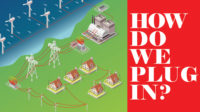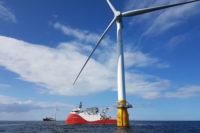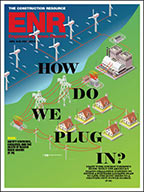Clean Energy Construction
NY Sets First US ‘Mesh-Ready’ Rules to Link Offshore Wind Power

New York and California are pushing new actions to speed up the clean energy transition at the state level, while a major U.S. utility says it is developing an estimated $13-billion offshore wind project off Vietnam set to generate more than 4 GW of power.
California Gov. Gavin Newsom in late July said he is committed to make “carbon neutrality state law” by increasing more zero-carbon power sources from wind, solar, geothermal and hydrogen, and also by sequestrating carbon in natural and working lands.
Newsom wants to speed development of natural and engineered carbon removal projects in the state and directed the California Air Resources Board to set a target to remove 20 million tons of carbon by 2030. He also directed the state energy commission to set a goal of at least 20 GW of offshore wind by 2045 and to work with federal agencies to accelerate deployment.
The new directive follows by one month Newsom's signing of a state budget with $54 billion for climate actions, including $100 million to support a network of methane detection satellites and $100 million to plug orphan oil wells.
But some environmental groups are not happy with Newsom’s plan. Mark Schlosberg, acting California director of Food & Watch Watch, said the governor and the air board “must stop kicking the can down the road" and no longer should support "fossil fuel industry schemes like carbon capture and hydrogen.”
NY Outlines Mesh-Ready Grid
New York released its third solicitation for offshore wind projects July 27, seeking proposals to develop at least 2 GW and as much as 4.6 GW, to bring the state closer to its target of 9 GW deployed by 2035.
New York currently has 4.3 GW of offshore wind being developed in five projects, the first of which—the 130-MW South Fork—started construction earlier this year by the joint venture of Denmark-based developer Ørsted and Massachusetts utility Eversource. Located 35 miles east of Montauk Point, it is set to operate in late 2023 and connect to the onshore grid in East Hampton, N.Y.
Eversource has said it intends to sell its 50% share of its venture with Ørsted, using what CFO John Moreira said in a recent earnings call could total $3 billion in proceeds to shift its development focus to offshore wind project grid connections in New York and in other states.
“We are in what I would say is the crown jewel of service territories,” Eversource CEO Joe Nolan told investors. “We are in the load center here. Whether it’s in Connecticut or Massachusetts, this is where the load is, and that’s where folks want to connect.” Nolan said the company expects to confirm a likely buyer in the fourth quarter and close the deal in 2023.
The latest New York solicitation also includes a stipulation that proposed projects include design of a “meshed ready” offshore transmission configuration outlined in a state power grid study that would link offshore substations to create a system with greater flexibility and reliability. The study recommended the meshed-ready option “likely at only modest incremental costs” that could also enable new interconnections with neighboring power markets and allow the system to “grow over time,” Hochul said.
The approach would be the first outlined by a state for U.S. offshore wind project transmission.
It is the result of a growing state, federal and industry focus on transmission infrastructure challenges faced by east coast and other states with progressive programs for offshore wind and other renewable energy and on the need to geographically broaden power delivery, as an ENR April cover story reported.
A study issued on Aug. 1 by Lawrence Berkeley National Lab says U.S. transmission planners likely are not considering the value of regional and interregional capability to improve grid reliability in extreme conditions and high-use periods. The Federal Energy Regulatory Commission also has proposed rule changes to require minimum amounts of interregional power transfer.
The New York solicitation also says that high-voltage direct-current (HVDC) technology will be required for all projects where cables will be installed in constrained areas. “If HVDC is used, projects must be mesh-ready to strengthen reliability and provide redundancy,” it says. More details on the requirement will be released by the N.Y. State Energy Research and Development Authority(NYSERDA) in mid-August.
The solicitation also includes the first phase of the state's $500-million investment in offshore wind ports, manufacturing and supply chain infrastructure.
The document also awards points for proposals that repurpose existing downstate fossil-based electric generation infrastructure, particularly in New York City, and for using energy storage. It also encourages project labor agreements backed by prevailing wages and sets minimum requirements for purchases of U.S.-made iron and steel.
Europe's Linked Transmission
Northern European countries are already working through financial and regulatory challenges in developing a common power grid under the North Sea to connect future offshore wind farms.
“We all know green power generation is great. But if you really want to use it, you need a grid, and there we have to step up,” European Commission President Ursula von der Leyensaid said in May.
Danish grid firm Energinet has floated plans for two energy islands in Denmark territory in the North and Baltic Seas that are set to link with Germany and Belgium. There are also talks with Norway, the Netherlands and Germany about future projects, a firm official told media.
Denmark, the Netherlands, Germany and Belgium announced plans in mid-May to build 150 GW of offshore wind capacity by 2050, up from about 15 GW today.
Asian Nations Boost Wind
In another sign of global interaction on offshore wind, Vietnam announced on July 29 that Virginia-based energy utility AES Corp. will develop a major offshore wind farm, which officials said would be a $13-billion investment able to generate 4GW of power.
AES, which operates in 15 countries, did not respond to a Reuters request for comment on the letter of intent it submitted to Vietnam to build the project.
Vietnam has about 4 GW of wind capacity currently and wants to install 11.7 GW by 2030 and 66 GW by 2045, said the Ministry of Industry and Trade in a statement.
Spanish-German turbine maker Siemens Gamesa also announced last month that it won its first "firm" offshore wind manufacturing order in Japan to build 14 turbines, each 8 MW, for the country's 112-MW Ishikara project, with installation set to start next year.
The firm did not disclose the contract value. Siemens Gamesa also said it has received 3 GW of “firm orders” for turbines from Taiwan.








